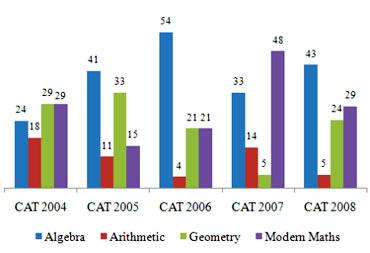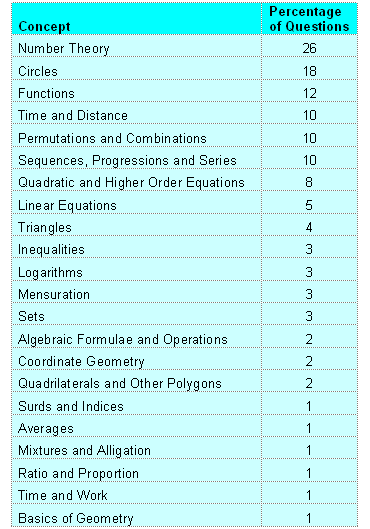When it comes to CAT, a very commonly asked question is about the relative importance given to different topics in the Quantitative Ability section of the test.  The unpredictability of the CAT has been one of the reasons that make it difficult to bell. However, the quant section has retained its charm while being challenging all the while. The following chart helps understand the break-up of QA section of CAT 2004 to CAT 2008. (Due to non-disclosure clause in CAT 2009, no data of CBT-CAT 2009 has been mentioned.)
The unpredictability of the CAT has been one of the reasons that make it difficult to bell. However, the quant section has retained its charm while being challenging all the while. The following chart helps understand the break-up of QA section of CAT 2004 to CAT 2008. (Due to non-disclosure clause in CAT 2009, no data of CBT-CAT 2009 has been mentioned.)
On analysing the data, you can interpret that no clear pattern emerges from this. More importantly, no topics can be completely ignored for your preparation. Going into greater detail, it is possible to identify the concepts that are most important in CAT -- going by the number of times that they have appeared from 2004 to 2008.
Number Theory accounted for almost 26 per cent of the 127 quant questions. Circles and Functions followed with 18 per cent and 12 per cent respectively. Here is the complete list of concepts that appeared in those five years, along with the percentage of questions from that topic.

In the table alongside, a question that requires application of more than one concept has been counted only once, under the central, primary concept area being tested. For instance, a question classified under the Number Theory concept could also require basic knowledge and application of percentages, averages and quadratic equations, but we count it only once, under the concept Number Theory. Or a functions question could test your knowledge of higher order algebraic equations or set theory.
The important concepts
Number Theory
Number Theory questions are usually based on classification of numbers (even-odd, prime-composite), HCF, LCM, divisibility, reversal of numbers, factorials, squares, cubes and base conversions. Many of these questions can be solved by testing different sets of numbers to satisfy conditions or by plugging in values in options.
Some others can be easily solved if you know divisibility rules for numbers like 2, 3, 4, 5, 8, 9, 11, 16 etc. Having knowledge of the Fundamental Principle of Counting, applications of the Binomial theorem to divisibility problems and notations of Set theory will definitely help.
Remember that these questions are on the easier side on a relative scale. However, to ace CAT, you will need regular practice to become comfortable and score well on these.
Circles
Here your knowledge of applying basic formulae -- area of circles, triangles, Pythagoras theorem, mid-point theorem and knowledge of definitions and properties -- tangents, chords and arcs comes into play. Certain sub-concepts such as basics of geometry, triangles, coordinate geometry, and arithmetic and geometric progressions very often feature in these questions.
More often than not, a fair amount of visualisation is important. There are only a few fundamentals to master in plane geometry, but an endless variety of questions. CBSE/NCERT textbooks of standards VIII, IX and X are a great place to learn the basics and past CAT questions a great place to apply them (even when you are a few weeks away from taking the CBT-CAT this year).
Functions
This is probably the most feared concept. You need to know how functions are represented analytically (algebraically) and graphically. Number theory, algebraic equations, inequalities and coordinate geometry are concepts that are generally required to answer these questions.
Functions have an uncanny knack of appearing difficult to a test-taker (when they are absolutely not). Do not decide whether to attempt a functions question based on how it appears at the first glance. With the CAT body stating that the number of questions in this year's CAT will be in the range of 60-70, you have time to decide on your attempts after having a good look at the questions.
Time and Distance
Time x Speed = Distance
We learnt this in the third standard. The faster you run, the faster you reach. The slower you run, more the time you take to reach. If two trains run towards each other, they collide faster than they would, if one was stationary and the other running. This is common sense, right? Well this is what Time and Distance questions in CAT are all about.
You need to understand the concept of relative speed very well. Once you understand and incorporate what average speed and variation means, Time and Distance questions will be a cakewalk for you.
Permutations and Combinations
This is one topic where most students falter, partly because it is generally taught in classes XI and XII, after which it is not really used, and partly because test-takers have a preconception that this is a very tough topic. Well, Permutations and Combinations can be rated as the most entertaining concept, if you get the hang of it.
You can start with simple applications of the Fundamental Principle of counting, which you will find in any good text book and slowly graduate to solving relatively complex questions on permutations and combinations. Past CAT questions will give you an idea of what kind of questions you can expect in the real test.
Do not take the risk of neglecting this concept since it is very useful in Number Theory.
Sequences, Progressions and Series
This concept covers mainly two types of questions. One involves identifying sequences of numbers that do not follow any predefined patterns using logic and the other involves use of arithmetic, geometric and harmonic progressions. The application of this concept also features in Functions, Geometry, Number Theory, and Time and Distance.
As you go through past CAT questions you will notice that there is hardly any topic that is completely absent. A single question may need an understanding of 3-4 different concepts. Therefore, not knowing one concept may put you at the risk of losing out on the choice of attempting a number of questions.
And with the CAT clearly showing a trend of reduced number of questions, you need to attempt more and leave less questions unattempted.
It is important to get the basics right across concepts, and then focus on the ones that you know are important. If you keep practicing new examples, you will master all fundamentals easily. The best way to learn, increase accuracy, scores and percentiles is by doing, rather than learning by rote.
Good luck with Quant!
www.TestFunda.com is the leader in online MBA test prep. With a core management team of 4 IIT-IIM alumni & 185,000+ registered users, TestFunda is a one-stop solution for all important MBA entrance tests. Get FREE downloadable tests of CAT, XAT, FMS, IIFT, JMET, NMAT, SNAP, Strategies by CAT 100%tilers and a whole host of learning resources.







 © 2025 Rediff.com -
© 2025 Rediff.com -